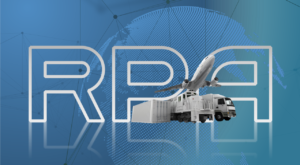Aside from a few historical plateaus and dips, the world has progressively become more automated and more technical. The current pace of change is making it hard for some workers to keep their feet and for some businesses to keep pace. One of the ground-shifting technologies receiving c-level attention is robotic process automation (RPA). There is a debate about whether RPA should fall under the artificial intelligence (AI) or automation rubric. For example, David Weldon (@DWeldon646) writes, “Robotic process automation is one area of artificial intelligence that is getting a lot of attention as organizations looks to streamline processes and cut costs.”[1] On the other hand, Sri Annaswamy, an outsourcing and analytics advisory specialist at Swamy and Associates, insists many RPA systems “are no more than larger versions of the universally used Excel macros.”[2] Regardless of how you look at RPA today, in the years to come, Weldon’s view will be closer to the mark.
What is RPA
Robotic process automation involves software robots or bots handling tedious or mundane routine tasks. Dianna Labrien (@DiLabrien) explains these tasks can include copying data from an Excel spreadsheet and pasting them into an online form, collecting data from varying sources like PDF files, eEmail, or web applications and generating a report, and verifying data matches between different systems.[3] She notes, “With the emergence of Robotic Process Automation … all this can be transformed. Now there are software robots to help with these laborious routines. Virtual robots mimic the actions of a human agent and can interact with applications and systems and manipulate them in order to complete any series of structured, computer based tasks.” She suggests there are four primary benefits derived from implementing RPA solutions: 1) reduced costs; 2) improved process speed, productivity, and accuracy; 3) more consistency through monitoring analytics; and, 4) scalability.
Harel Tayeb (@hareltayeb), CEO of Kryon Systems, believes business leaders should think of RPA as an entry-level employee or an aide to current employees. “The rise of Robotic Process Automation,” he writes, “is a great example of a process that integrates robotics into the workplace without rendering humans irrelevant. … Using robots to handle the most mundane assignments will free up human workers to focus on more important and creative tasks.”[4] Sathish PV, Practice Head for RPA at Happiest Minds Technologies, reports, “A survey done by McKinsey [suggests] automation technology has the potential to impact the economy by $6.7 trillion by 2025, which explains the rush that businesses are in to implement Robotic Process Automation.”[5]
Beyond RPA
PV notes, “Although RPA manages processes intuitively, the robots are ‘dumb’; they do exactly as trained, with unwavering compliance.” For routine processes, that’s exactly what you want. He goes on to explain RPA works best when data is structured. Unfortunately, much of today’s data is unstructured. He suggests cognitive technologies can help overcome this limitation. He explains, “Cognitive intelligence combined with machine learning builds this ability in RPA where it can deal with the unstructured, or semi-structured data and transform it into a structured form, which can then be processed by the robots.” Saleha Anwar, a lead business consultant at GFT, agrees with PV that some processes require more than a rules-based system. She explains, “If the process is: ambiguous, unstructured, not rules-based, has high exception rates and complexity, or if there are large amounts of data, then Artificial Intelligence can be employed as this can manage greater variability. AI can improve over time, since AI robots have the ability to ‘self-learn’ whereas RPA capabilities are … limited.”[6] I tell clients, if they want to improve processes and not simply automate them, they should be thinking in terms of Cognitive Process Automation™ (CPA) rather than Robotic Process Automation. CPA is powered by cognitive computing platforms, like the Enterra Enterprise Cognitive System™ (AILA®) — a system that can Sense, Think, Act, and Learn®. Cognitive computing combines artificial intelligence, advanced mathematics, and natural language processing. It can be applied to an almost unlimited number of business use cases, including process automation.
Cognitive technologies can do more than manage data. They can help transform Industrial Age enterprises into intelligent enterprises. Paul Maguire, a Vice President at Appian, writes, “With the promise of ‘intelligent automation’ now becoming a reality, it is essential for businesses to shake off any apprehension and set their sights on creating an environment where artificial intelligence, business process management, and robotic process automation can operate cohesively and effectively. Intelligent businesses are becoming synonymous with intelligent automation. The quicker business leaders can realize this, the better.”[7]
Summary
PV concludes, “RPA fails when it comes to decision making in a process. … If the decision is relatively simple, it can still be handled by RPA. However, complex decisions need the intelligence of cognitive techniques. Hence the combination of RPA and cognitive intelligence will allow users to do end to end automation for many processes, and achieve greater efficiency benefits as compared to the partially automated ones.” In other words, companies win when they become intelligent enterprises. Maguire adds, “Despite businesses feeling unprepared for new, digital models, they must navigate a course towards digital transformation or risk losing out. … It now remains to be seen which intelligent businesses embrace intelligent automation. It’s the easiest decision they’ll ever make.”
Footnotes
[1] David Weldon, “What’s the best job for robotic process automation?” Information Management, 6 June 2016.
[2] Dick Weisinger, “Robotic Process Automation (RPA): Closer to a Rules Engine than to Artificial Intelligence (AI)?” Formtek Blog, 3 October 2017.
[3] Dianna Labrien, “4 Ways Robotic Process Automation Will Help Your Business,” Tech.co, 19 February 2016.
[4] Harel Tayeb, “Robots are friends, not foes,” Globes, 20 June 2017.
[5] Sathish PV, “Evolution of RPA: From rule-based to intelligent cognitive automation,” CIO Dive, 11 June 2018.
[6] Saleha Anwar, “Robotic Process Automation: Taking the Robot out of the Human,” Finextra, 5 February 2018.
[7] Paul Maguire, “Intelligent automation for intelligent businesses,” Business Chief, 28 June 2018.





